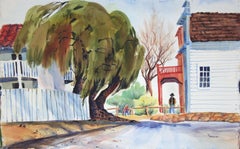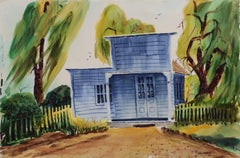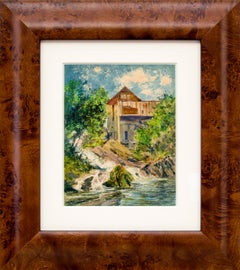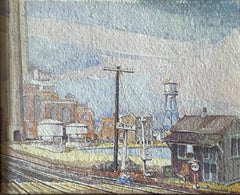L. Heebner Art
to
2
2
Overall Width
to
Overall Height
to
2
1
2
2
2
1
1
1
1
1
1
1
1
1
1
2
2
2
1
2
10,025
2,754
1,379
1,375
2
Artist: L. Heebner
Gold Rush Town Columbia, California Landscape by Lillie Heebner
By L. Heebner
Located in Soquel, CA
Colorful figurative landscape watercolor painting of Columbia, California, showing two men in cowboy hats. By Lillie Eesther (Hillman) Heebner, a Monterey Bay area artist. Signed "L....
Category
1970s American Impressionist L. Heebner Art
Materials
Watercolor, Laid Paper
$268 Sale Price
20% Off
Returning Home, Watsonville California Blue Farmhouse Landscape Watercolor
By L. Heebner
Located in Soquel, CA
Beautiful watercolor painting of a quaint blue farmhouse surrounded by lush green trees by Lillie Esther (Hillman) Heebner (American, 1923-2016), a Watsonville, Monterey Bay area artist. Signed "L.E. Heebner" bottom right. Unframed. Image: 15"H x 23"W.
Lillie (Lil) E. Heebner was guided through life by her creativity. Even at 92, she never felt old, and often said so. She met every situation in life—including death—with ingenuity.
Although born in Richmond, Lillie lived in Watsonville all her life. Her father, Frederick H. Hillman, grew up on a strawberry ranch in Pajaro, graduated from Watsonville High School in 1916, and served in France during World War I. He later worked for Martinelli's Apple Cider plant and became foreman. Lillie's mother, Esther C. Hobson, moved as an infant from Bakersfield to Santa Cruz with her family in 1901, when they founded Hobson's Bath House at the Santa Cruz Boardwalk...
Category
Mid-20th Century American Impressionist L. Heebner Art
Materials
Paper, Watercolor
Related Items
Charles Partridge Adams “New England Mill” c.1900 Original Watercolor Landscape
By Charles Partridge Adams
Located in Denver, CO
This circa 1900 original watercolor by renowned American landscape artist Charles Partridge Adams (1858–1942) captures a tranquil New England scene near Plainfield, New Hampshire. A ...
Category
20th Century American Impressionist L. Heebner Art
Materials
Watercolor
$2,850
H 13.75 in W 12.25 in D 1.25 in
"Train Station, " Max Kuehne, Industrial City Scene, American Impressionism
By Max Kuehne
Located in New York, NY
Max Kuehne (1880 - 1968)
Train Station, circa 1910
Watercolor on paper
8 1/4 x 10 1/4 inches
Signed lower right
Provenance:
Private Collection, Illinois
Max Kuehne was born in Halle, Germany on November 7, 1880. During his adolescence the family immigrated to America and settled in Flushing, New York. As a young man, Max was active in rowing events, bicycle racing, swimming and sailing. After experimenting with various occupations, Kuehne decided to study art, which led him to William Merritt Chase's famous school in New York; he was trained by Chase himself, then by Kenneth Hayes Miller. Chase was at the peak of his career, and his portraits were especially in demand. Kuehne would have profited from Chase's invaluable lessons in technique, as well as his inspirational personality. Miller, only four years older than Kuehne, was another of the many artists to benefit from Chase's teachings. Even though Miller still would have been under the spell of Chase upon Kuehne's arrival, he was already experimenting with an aestheticism that went beyond Chase's realism and virtuosity of the brush. Later Miller developed a style dependent upon volumetric figures that recall Italian Renaissance prototypes.
Kuehne moved from Miller to Robert Henri in 1909. Rockwell Kent, who also studied under Chase, Miller, and Henri, expressed what he felt were their respective contributions: "As Chase had taught us to use our eyes, and Henri to enlist our hearts, Miller called on us to use our heads." (Rockwell Kent, It's Me O Lord: The Autobiography of Rockwell Kent. New York: Dodd, Mead and Co., 1955, p. 83). Henri prompted Kuehne to search out the unvarnished realities of urban living; a notable portion of Henri's stylistic formula was incorporated into his work.
Having received such a thorough foundation in art, Kuehne spent a year in Europe's major art museums to study techniques of the old masters. His son Richard named Ernest Lawson as one of Max Kuehne's European traveling companions. In 1911 Kuehne moved to New York where he maintained a studio and painted everyday scenes around him, using the rather Manet-like, dark palette of Henri.
A trip to Gloucester during the following summer engendered a brighter palette. In the words of Gallatin (1924, p. 60), during that summer Kuehne "executed some of his most successful pictures, paintings full of sunlight . . . revealing the fact that he was becoming a colorist of considerable distinction." Kuehne was away in England the year of the Armory Show (1913), where he worked on powerful, painterly seascapes on the rocky shores of Cornwall. Possibly inspired by Henri - who had discovered Madrid in 1900 then took classes there in 1906, 1908 and 1912 - Kuehne visited Spain in 1914; in all, he would spend three years there, maintaining a studio in Granada. He developed his own impressionism and a greater simplicity while in Spain, under the influence of the brilliant Mediterranean light. George Bellows convinced Kuehne to spend the summer of 1919 in Rockport, Maine (near Camden). The influence of Bellows was more than casual; he would have intensified Kuehne's commitment to paint life "in the raw" around him.
After another brief trip to Spain in 1920, Kuehne went to the other Rockport (Cape Ann, Massachusetts) where he was accepted as a member of the vigorous art colony, spearheaded by Aldro T. Hibbard. Rockport's picturesque ambiance fulfilled the needs of an artist-sailor: as a writer in the Gloucester Daily Times explained, "Max Kuehne came to Rockport to paint, but he stayed to sail." The 1920s was a boom decade for Cape Ann, as it was for the rest of the nation. Kuehne's studio in Rockport was formerly occupied by Jonas Lie.
Kuehne spent the summer of 1923 in Paris, where in July, André Breton started a brawl as the curtain went up on a play by his rival Tristan Tzara; the event signified the demise of the Dada movement. Kuehne could not relate to this avant-garde art but was apparently influenced by more traditional painters — the Fauves, Nabis, and painters such as Bonnard. Gallatin perceived a looser handling and more brilliant color in the pictures Kuehne brought back to the States in the fall. In 1926, Kuehne won the First Honorable Mention at the Carnegie Institute, and he re-exhibited there, for example, in 1937 (Before the Wind). Besides painting, Kuehne did sculpture, decorative screens, and furniture work with carved and gilded molding. In addition, he designed and carved his own frames, and John Taylor Adams encouraged Kuehne to execute etchings. Through his talents in all these media he was able to survive the Depression, and during the 1940s and 1950s these activities almost eclipsed his easel painting. In later years, Kuehne's landscapes and still-lifes show the influence of Cézanne and Bonnard, and his style changed radically.
Max Kuehne died in 1968. He exhibited his work at the National Academy of Design, the Art Institute of Chicago, the Carnegie Institute in Pittsburgh, the Memorial Art Gallery of the University of Rochester, and in various New York City galleries. Kuehne's works are in the following public collections: the Detroit Institute of Arts (Marine Headland), the Whitney Museum (Diamond Hill...
Category
1910s American Impressionist L. Heebner Art
Materials
Paper, Watercolor
$2,800 Sale Price
20% Off
H 13.5 in W 15.5 in
Planting (Spring Plowing) - Watercolor Landscape Painting with Figures, c. 1939
By Thomas Hart Benton
Located in Palm Desert, CA
"Planting (Spring Plowing)", a vibrant watercolor and graphite on paper by Thomas Hart Benton, circa 1939-40, embodies the artist's signature Regionalist style. The work depicts a ru...
Category
Mid-20th Century American Impressionist L. Heebner Art
Materials
Paper, Watercolor, Graphite
Near Half Moon Bay, California
By Ted Lewy
Located in San Francisco, CA
This artwork "Near Half Moon Bay, California" 1962 is a watercolor on paper by noted California artist Ted Lewy, 1912-1963. It is hand signed at the lower right corner by the artist,...
Category
Mid-20th Century American Impressionist L. Heebner Art
Materials
Watercolor
Canyon Country, 16x20, watercolor landscape, framed
By Lu Haskew
Located in Loveland, CO
Canyon Country by Lu Haskew
Pastel 16x20" image size
Additional images available upon request.
Landscape view of the Grand Canyon
ABOUT THE ARTIST: Lu Haskew 1921-2009
"Life is good to me. Being able to go to my studio five days weekly and paint for several hours, living in a supportive community, having family and friends who encourage me--all have contributed to helping me become an artist. Being fortunate to study with some of the artists I admire has kept me painting from the garden, people and my favorite things. With the support of galleries, teaching and doing demos, how could I do anything else? My goal is to try to be the best I can be by always being a student, looking for new ideas and stretching my horizons."
Upon retirement from a 33-year teaching career, Lu rented a studio in Loveland and began concentrating on
her oil and watercolor painting. Learning from artists she had followed and admired throughout the years
her painting became a full time career. Since 1992, she has studied with renowned painters Richard
Schmid, Clyde Aspevig, Joyce Pike, and others at the Scottsdale Art...
Category
1990s American Impressionist L. Heebner Art
Materials
Watercolor
Village de Provence
Located in San Francisco, CA
This artwork "Village de Provence" c.1990 is a watercolor on paper by American impressionist artist Sharon Galigan, b.1939. It is hand signed at the lower left corner by the artist. The artwork size is 17.5 x 13.75 inches, framed size is 25.5 x 22.5 inches. Custom framed in a wooden light brown and grey frame, with beige matting and light brown filet. It is in excellent condition.
About the artist:
Sharon Galligan (American, b. 1939) is an artist painting in watercolor, oil, acrylic, monoprint and mixed media. She was an art major in both high school and college: San Jose State University, West Valley College, and Evergreen College. She has also studied with nationally noted artists and teachers, including Ted Goeschner, Frank Webb, Charles Movali, Howard Rees, Tom Lynch, Dale Laitinen, Marilyn Simandle...
Category
Late 20th Century American Impressionist L. Heebner Art
Materials
Watercolor
Landscape with House
Located in San Francisco, CA
This artwork "Landscape with House" is a watercolor by noted California artist Earl Thollander, 1923-2001. It is signed at the lower right corner by th...
Category
Late 20th Century American Impressionist L. Heebner Art
Materials
Watercolor
Mount Monadnock
By Gifford Beal
Located in Milford, NH
A fine monochromatic watercolor landscape painting of Mount Monadnock in New Hampshire by American artist Gifford Beal (1879-1956). Beal was b...
Category
Mid-20th Century American Impressionist L. Heebner Art
Materials
Paper, Watercolor
Little Church on Pond, Harrisville, New Hampshire
By Ted Lewy
Located in San Francisco, CA
This artwork "Little Church on Pond, Harrisville, New Hampshire" 1953, is a watercolor on paper by noted California artist Ted Lewy, 1912-1963. It is hand signed at the lower right c...
Category
Mid-20th Century American Impressionist L. Heebner Art
Materials
Watercolor
'Landscape', New York, Boston Art Club, London, PAFA, AWS, NAD, Benezit
Located in Santa Cruz, CA
Signed lower right, 'Rhoda Holmes Nicholls' (British-American, 1854-1948) with dedication 'To my dear friend Marietta M. Andrenes'.
Framed dimensions: 16.75 H x 1.25 D x 10.5 W inche...
Category
Early 20th Century American Impressionist L. Heebner Art
Materials
Paper, Watercolor
$4,500
H 12.25 in W 6.25 in D 0.13 in
Crater Lake, Oregon
By Ted Lewy
Located in San Francisco, CA
This artwork "Crater Lake,Oregon" 1962 is a watercolor on paper by noted California artist Ted Lewy, 1912-1963. It is hand signed at the lower right corner by the artist, dated and t...
Category
Mid-20th Century American Impressionist L. Heebner Art
Materials
Watercolor
"Monhegan Island, Maine, " Edward Dufner, American Impressionism Landscape View
By Edward Dufner
Located in New York, NY
Edward Dufner (1872 - 1957)
Monhegan Island, Maine
Watercolor on paper
Sight 16 x 20 inches
Signed lower right
With a long-time career as an art teacher and painter of both 'light' and 'dark', Edward Dufner was one of the first students of the Buffalo Fine Arts Academy to earn an Albright Scholarship to study painting in New York. In Buffalo, he had exchanged odd job work for drawing lessons from architect Charles Sumner. He also earned money as an illustrator of a German-language newspaper, and in 1890 took lessons from George Bridgman at the Buffalo Fine Arts Academy.
In 1893, using his scholarship, Dufner moved to Manhattan and enrolled at the Art Students League where he studied with Henry Siddons Mowbray, figure painter and muralist. He also did illustration work for Life, Harper's and Scribner's magazines.
Five years later, in 1898, Dufner went to Paris where he studied at the Academy Julian with Jean-Paul Laurens and privately with James McNeill Whistler. Verification of this relationship, which has been debated by art scholars, comes from researcher Nancy Turk who located at the Smithsonian Institution two 1927 interviews given by Dufner. Turk wrote that Dufner "talks in detail about Whistler, about how he prepared his canvasas and about numerous pieces he painted. . . A great read, the interview puts to bed" the ongoing confusion about whether or not he studied with Whistler.
During his time in France, Dufner summered in the south at Le Pouleu with artists Richard Emil Miller...
Category
Early 20th Century American Impressionist L. Heebner Art
Materials
Paper, Watercolor
L. Heebner art for sale on 1stDibs.
Find a wide variety of authentic L. Heebner art available for sale on 1stDibs. You can also browse by medium to find art by L. Heebner in paint, paper, watercolor and more. Much of the original work by this artist or collective was created during the 20th century and is mostly associated with the Impressionist style. Not every interior allows for large L. Heebner art, so small editions measuring 23 inches across are available. Customers who are interested in this artist might also find the work of Diane Baldwin, Virginia J. Hughins, and Arnold A. Grossman. L. Heebner art prices can differ depending upon medium, time period and other attributes. On 1stDibs, the price for these items starts at $268 and tops out at $340, while the average work can sell for $304.



